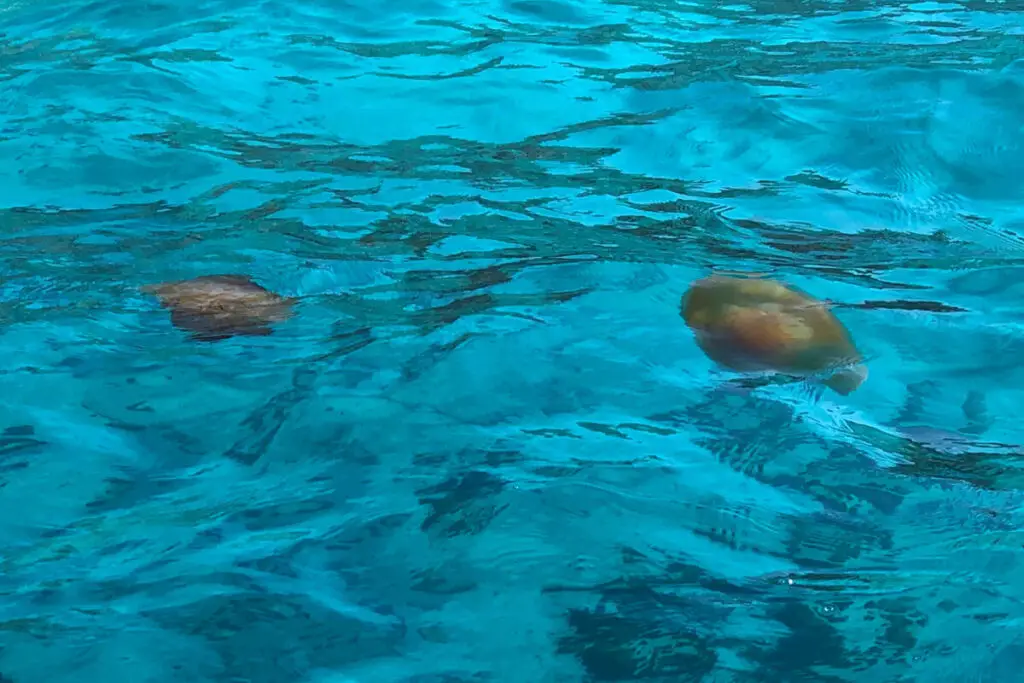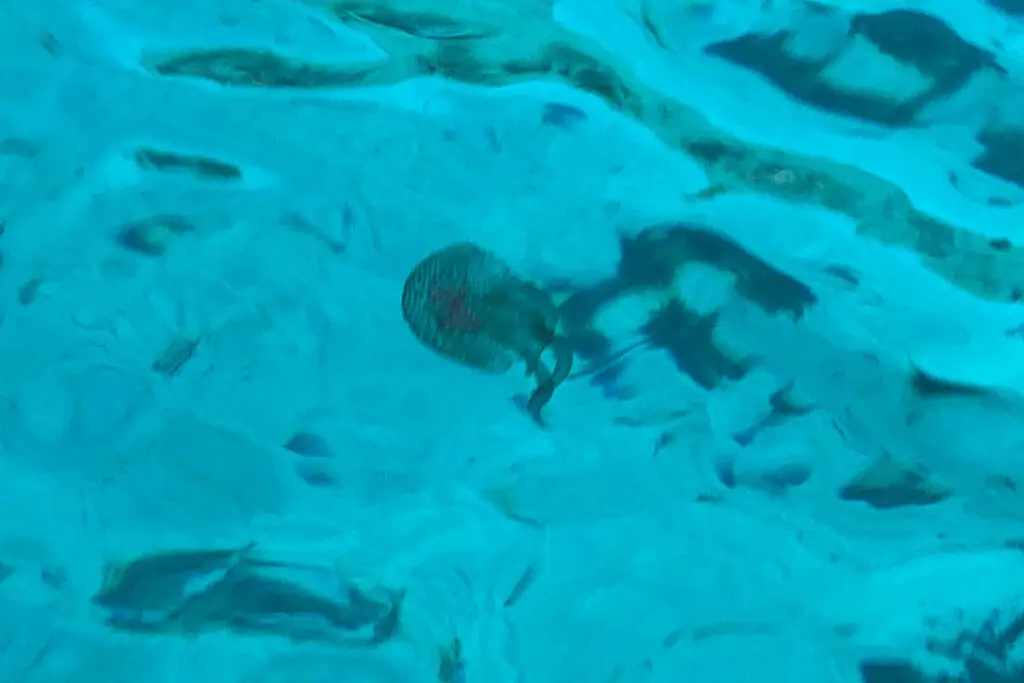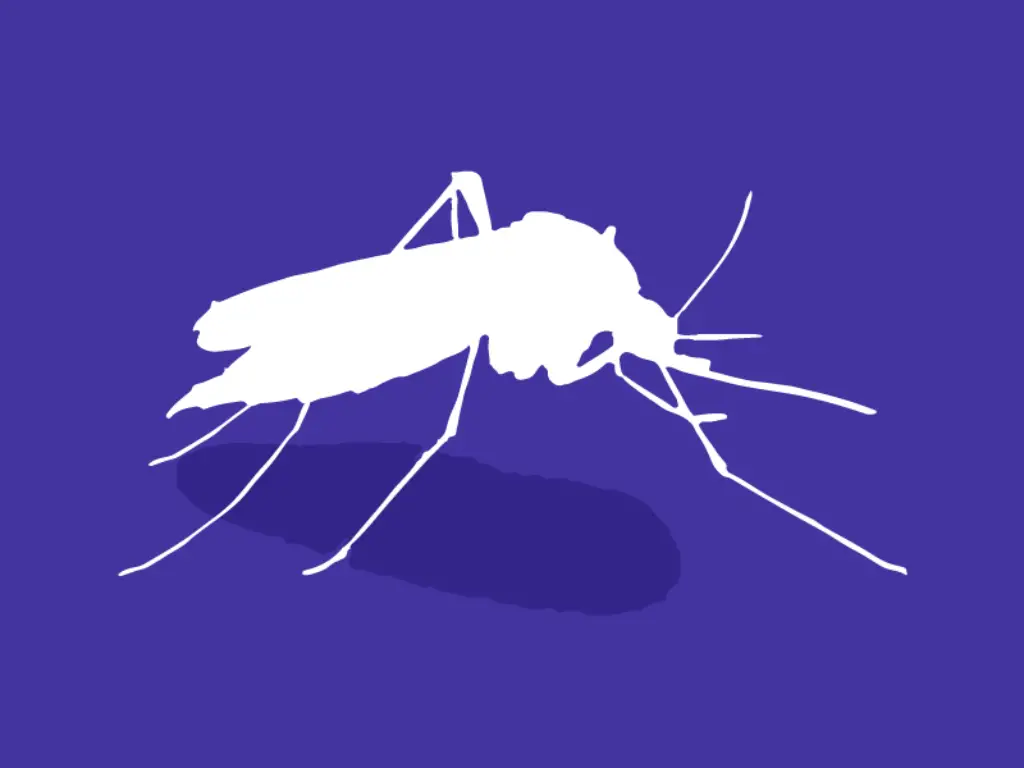Jellyfish in Mallorca | Types | Best Bays | Treatment
Season for Jellyfish
Jellyfish season in Mallorca typically occurs during the summer months, from May to September. However, the exact timing and abundance of jellyfish can vary each year due to factors such as water temperature, currents, and environmental conditions.
At times there are plenty of jellyfish in the sea, but they do not come close to the coast. For example, during my summer trip in Mallorca in 2023 I had the opportunity to swim in various beaches on the north, south, east and west of the island. I enjoyed the gorgeous beaches there and not once did I spot a jellyfish.
In fact it looked as though 2023 would be a good year with less jellyfish in the Mediterranean. Malta’s beaches (I’m Maltese) are also experiencing less of the uninvited guests. However while I was on holiday I found out that the Maltese Olympic swimmer Neil Agius had to abort his 100-mile Malloca to Ibiza swim due to a swarm of jellyfish.
Hopefully you will not encounter them at all while you are on holiday. Or at least there will be so few you can easily dodge them.
Mild to Poisonous Jellyfish to Look Out For
Different species of jellyfish have different stings that range from not having a sting whatsoever, to poisonous ones.
Most jellyfish in Mallorca are not dangerous, resulting in some minor irritation. These include the Barrel, Fried Egg, Moon and White-Spotted Jellyfish. The Mauve Stinger and Compass Jellyfish stings are more painful. While the Portuguese Man o’War is known for its potent and painful sting, fatalities are rare.
It’s important to remember that individual reactions to jellyfish stings can vary. Some people may be more sensitive or have allergic reactions. Hence it’s always a good idea to exercise caution and avoid direct contact with any jellyfish you encounter, regardless of their perceived level of sting.
The good thing is you can easily treat the most common jellyfish stings. Apart from following some basic steps for treating stings which I detail further down, an inexpensive bottle of After Bite which you can buy from Amazon or select pharmacies, is an invaluable asset to keep on hand.
This popular and highly effective soothing treatment is specifically designed to provide quick and targeted relief from jellyfish stings, as well as discomfort caused by insects and nettles. After Bite is also compact and portable, making it the perfect companion for beach trips so you can fully enjoy your time in the water with peace of mind.
Here is more information on the jellyfish in Mallorca you can encounter and what to do in particular situations.
Barrel Jellyfish (Rhizostoma Pulmo)
Also known as the dustbin-lid jellyfish, the barrel jellyfish is characterized by its large, barrel-shaped bell that can reach up to one meter in diameter. It is typically milky-white or pale blue and has frilly oral arms.
Fried Egg Jellyfish (Cotylorhiza Tuberculata)

This jellyfish species has a flattened bell with a yellowish-brown or cream coloration, resembling a fried egg. It often has distinctive radial lines on the bell’s surface and short, branched tentacles.
Moon Jellyfish (Aurelia Aurita)
Moon Jellyfish are translucent and have a saucer-shaped bell with four distinctive horseshoe-shaped gonads visible through the bell. They have short tentacles and are typically found in calm coastal waters. This jellyfish has a mild to insignificant sting.
White-Spotted Jellyfish (Phyllorhiza Punctate)
This jellyfish has a translucent bell with white spots and frilly oral arms. It is typically found in warmer waters, including the Mediterranean Sea. The white-spotted jellyfish is known to have a mild sting, which is generally harmless to humans.
Mauve Stinger (Pelagia Noctiluca)

This is one of the most common and widely recognized jellyfish species in the Mediterranean Sea. It has a bell-shaped body with a pinkish-purple colour and long, trailing tentacles.
The Mauve stinger is equipped with stinging cells, called nematocysts, on its tentacles. It uses them to capture prey and defend itself.
The sting of a Mauve stinger can cause varying degrees of discomfort. The pain can range from mild irritation to more severe, depending on the individual’s sensitivity and the extent of contact with the jellyfish tentacles.
In some cases, the sting can lead to redness, itching, inflammation, and raised welts on the skin. Some people may have allergic reactions or be more sensitive to the venom of the Mauve stinger, which can amplify the symptoms.
Compass Jellyfish (Chrysaora Hysoscella)
The compass jellyfish has a bell with brownish radial lines resembling a compass rose. It has long, delicate tentacles with stinging cells used to capture prey.
It is known to have a more potent and potentially more painful sting compared to the Mauve stinger. While individual reactions can vary, encounters with the Compass jellyfish can result in a more significant level of discomfort and pain.
Portuguese Man o’War (Physalia Physalis)
The Portuguese Man o’War resembles a floating, transparent bladder or balloon with long, tentacle-like structures hanging beneath it. These tentacles can be several meters long and are typically bright blue or purple in colour.
The Portuguese Man o’War is jellyfish-like, but actually a siphonophore and not a jellyfish. Although they are related to jellyfish, they are unique and different to them.
Siphonophores are colonies of individual organisms, that are interconnected and function together as a single organism. They are quite fascinating creatures, but they do sting like jellyfish.
Some have mild stings, while others like the Portuguese Man o’War can cause serious discomfort. More discomfort than the Mauve Stinger or the Compass Jellyfish. In fact it is the only known species that has caused ‘jellyfish’ deaths thus far in the Mediterranean Sea.
It is important to note that most people that get stung by the Portuguese Man o’War live to tell the tale. However if you spot one you should keep well away from it. Additionally please call the emergency line on 112 to notify authorities and the life guard if you are on or close to the beach.
Forskalia Edwardsi
There is another siphonophore called Forskalia Edwardsi spotted by divers for the first time in 2022 in the El Toro marine reserve in Mallorca. It is like a translucent sea snake that sometimes has an orange or reddish colouring.
The Forskalia edwardsi, is less dangerous than the Portuguese Man o’ War. Even though both species belong to the same family, the Portuguese Man o’ War is known for its more potent and painful sting and generally causes more significant reactions in humans. Forskalia edwardsi’s sting is milder and poses a lower risk to human health.
Best Bays Where to Swim
In Mallorca there aren’t any online tools that suggest the best live bays to avoid jellyfish like Malta does. However since jellyfish are passive drifters and are carried by ocean and sea currents, you can guestimate where you can find jellyfish in Mallorca based on wind direction.
This is by no means a fool proof method because sea currents are influenced by various factors. These include temperature, salinity, tides, and the shape of coastlines which also come into play.
These factors interact with each other to create complex patterns of ocean and sea currents that sometimes align with or are influenced by prevailing wind directions. Although it is not a direct one-to-one relationship, winds can play a significant role in creating currents.
Most of the time, and eventually the sea current does shift to follow the wind direction. Hence you could narrow down your selection of the best beaches in Mallorca and more optimally pick one to avoid jellyfish.
For example, if the wind is from the east, Camp de Mar is a great sheltered spot. Whereas if there is a westerly wind Port de Polenca, Cala Millor and others are brilliant.
Avoiding the Portuguese Man o’War
Avoiding the Portuguese Man o’War requires a different strategy to other jellyfish that are native to the Mediterranean. This is because it is a native species of the Indian, Pacific and Atlantic Oceans. It is pushed by westerly winds into the Mediterranean Sea from the Atlantic Ocean through the Straits of Gibraltar.
Since it carried by the wind, there are less and less of them the further east you go from the Straits of Gibraltar. On average there are sightings around once a year in Malta, which is at the heart of the Mediterranean Sea. However that means some years there are more and some years have no sightings whatsoever.
Mallorca has more sightings of Portuguese Man o’War to the point where they have swarms of them infesting their waters. On occasion it is so bad that authorities in Mallorca have closed beaches and costal attractions.
However this does not happen on a yearly basis, as such sightings in Mallorca only started in 2018. So far only in 2010, 2013 and 2018 there were swarms of Portuguese Man o’War at the Straits of Gibraltar.
Moreover the authorities have developed a tool as an early warning signal to minimise or eradicate closures and other issues. The authorities should keep everyone informed should there be any issues anywhere.
However you could also pick beaches where you would like to swim strategically to play it safe. In Malta, beach goers have only spotted the Portuguese Man o’War on the west side of the island. Hence beaches that are facing the east in Mallorca should get less if any of the uninvited guests.
Treating a Jellyfish Sting
If you get stung by a jellyfish or siphonophore, it’s important to check how bad it is. Most jellyfish stings in Mallorcan waters cause mild discomfort and irritation. Here’s what you can do to treat them.
- Rinse the sting area with seawater for 5-10 minutes.
- Use a flat object like a credit card to gently scrape the area, even if you can’t see any stinging cells.
- Apply vinegar, alcohol, or After Bite (available on Amazon) to prevent toxins from being released by the stinging cells.
After Bite comes in a compact and portable bottle shaped like a pen and light weight that is easier to carry around than vinegar or alcohol. Hence why I suggested it earlier to always keep it at hand when you go to the beach. Plus you can leave it in your medicine cabinet to use for other bites and insect stings.
Treating a Portuguese Man o’War Sting
- Tell the lifeguard or call the emergency number 112 if there’s no lifeguard. They will help you with what to do.
- Use seawater to rinse the sting. Don’t use rubbing alcohol, freshwater, or ice because they can make things worse.
- Scrape off the stingers gently.
- Apply a warm pack to the area.
- Keep an eye on how you feel and how the sting is doing.
When to Seek Medical Treatment
In general, the discomfort from mild jellyfish stings subside on their own within a few hours up to a couple of days. On the other hand more potent stings require more time to heal.
However not everyone is the same and some may have shorter or longer lasting discomfort. For any jellyfish sting, you should consult a doctor if you experience any other following symptoms:
- Severe pain or allergic reaction
- Stung by a Portuguese Man o’War
- Multiple stings or coverage over a large area of the body
- Persistent symptoms
Related Articles

Mallorca Family Holidays, Kids Activities, Itineraries, Guides

Driving in Mallorca: Driving Culture, Rules, Tolls and More

Mosquitos in Mallorca: Season, Avoiding and Treatment